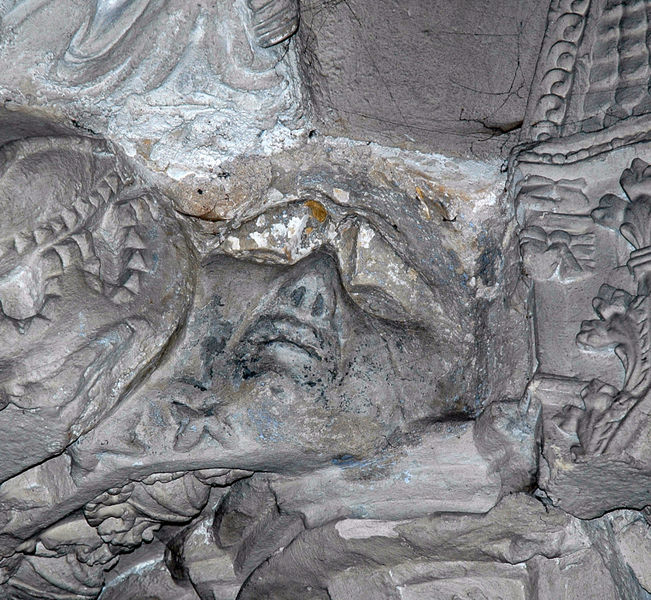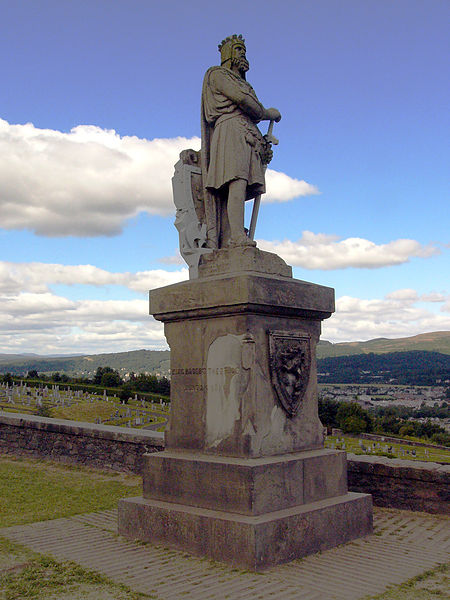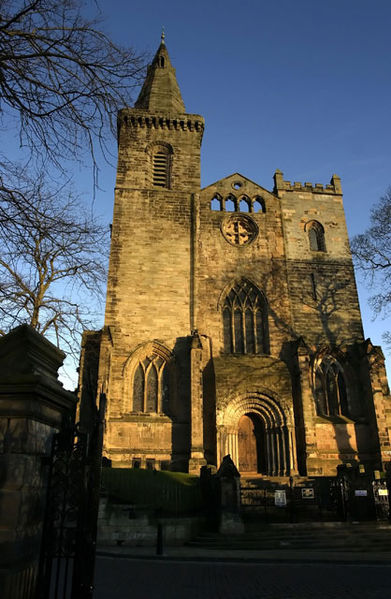<Back to Index>
- Jurist and Philosopher Carl Schmitt, 1888
- Painter Roger de La Fresnaye, 1885
- King of Scots Robert I the Bruce, 1274
PAGE SPONSOR
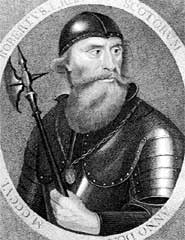
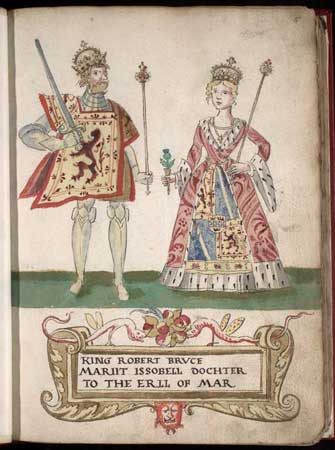
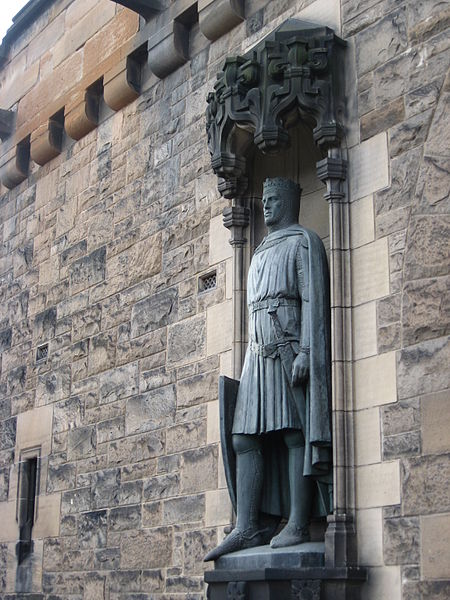
Robert I (11 July 1274 – 7 June 1329), often known as Robert the Bruce (Medieval Gaelic: Roibert a Briuis; modern Scottish Gaelic: Raibeart Bruis; Norman French: Robert de Brus or Robert de Bruys), was King of Scots from March 25, 1306, until his death in 1329.
His paternal ancestors were of Scoto - Norman heritage (originating in Brix, Manche, Normandy), and his maternal of Franco - Gaelic. He became one of Scotland's greatest kings, as well as one of the most famous warriors of his generation, eventually leading Scotland during the Wars of Scottish Independence against the Kingdom of England. He claimed the Scottish throne as a fourth great-grandson of David I of Scotland, and saw the recognition of Scotland as an independent nation during his reign. Today in Scotland, Bruce is remembered as a national hero. His body is buried in Dunfermline Abbey, while his heart is buried in Melrose Abbey. His embalmed heart was to be taken on crusade by his lieutenant and friend Sir James Douglas to the Holy Land, but only reached Moorish Granada, where it acted as a talisman for the Scottish contingent at the Battle of Teba. Robert was the first son of Robert de Brus, 6th Lord of Annandale and Marjorie, Countess of Carrick. His
mother was by all accounts a formidable woman who, legend would have
it, kept Robert Bruce's father captive until he agreed to marry her.
From his mother, he inherited the Gaelic Earldom of Carrick,
and through his father a Royal lineage that would give him a claim to
the Scottish throne. Although his date of birth is known, his place of birth is less certain, but it was probably Turnberry Castle in Ayrshire. Very
little is known of his youth. He was probably brought up in a mixture
of the Anglo - French culture of northern England and south - eastern
Scotland, and the Gaelic culture of Carrick and the Irish Sea, French
being his father tongue and Gaelic his mother tongue. He
may have been fostered with a local family, as was the custom (Barbour
mentions his foster brother); it is suspected that his brother Edward was fostered with his second cousin Domhnall O'Neill. Robert's first appearance in history is on a witness list of a charter issued by Alasdair MacDomhnaill, Lord of Islay. His name appears in the company of the Bishop of Argyll, the vicar of Arran, a Kintyre clerk, his father and a host of Gaelic notaries from Carrick. In
1292 his mother died, elevating the 18 year old Robert to the Earldom
of Carrick; this had the side effect of stripping his father of his jure uxoris claim to the title and lands. In November of the same year he saw Edward I, on behalf of the Guardians of Scotland, award the vacant Crown of Scotland to his grandfather's first cousin once removed, John Balliol, after a lobbying campaign known as the 'Great Cause'. Almost immediately his grandfather, Robert de Brus, 5th Lord of Annandale, resigned his Lordship of Annandale to Robert's father, possibly to avoid having to swear fealty to John as a vassal lord. Later both father and son sided with Edward I against John, whom they considered a usurper and to whom Robert had not sworn fealty. In
April 1294, the younger Bruce had permission to visit Ireland for a
year and a half, and, as a further mark of King Edward's favour, he
received a respite for all the debts owed by him to the English
Exchequer. In 1295, Robert married his first wife, Isabella of Mar, the daughter of Domhnall I, Earl of Mar, and his wife Helen. Some sources claim that Helen was the daughter of the Welsh ruler Llywelyn ap Iorwerth, Prince of North Wales, Llywelyn 'The Great' (1173 – 1240) and his spouse Joan, Lady of Wales, an illegitimate child of King John of England.
However, as both Llywelyn and Joan were dead by 1246, that theory would
most likely be incorrect. However, there are suggestions that Helen may
have in fact been the daughter of Llywelyn's son Dafydd ap Llywelyn and his Norman wife Isabella de Braose, of the south Wales dynasty of Marcher Lords. In August 1296, Bruce and his father swore fealty to Edward I of England at Berwick - upon - Tweed, but in breach of this oath, which had been renewed at Carlisle,
the younger Robert supported the Scottish revolt against King Edward in
the following year. Urgent letters were sent ordering Bruce to support
Edward's commander, John de Warenne, 6th Earl of Surrey (to
whom Bruce was related) in the summer of 1297; but instead of
complying, Bruce continued to support the revolt against Edward. On 7
July, Bruce and his friends made terms with Edward by a treaty called
the Capitulation of Irvine.
The Scottish lords were not to serve beyond the sea against their will,
and were pardoned for their recent violence in return for swearing
allegiance to King Edward. The Bishop of Glasgow, James the Steward,
and Sir Alexander Lindsay became sureties for Bruce until he delivered
his infant daughter Marjorie as a hostage which he never did, and he was soon actively fighting for the Scots again. Shortly after the Battle of Stirling Bridge, Bruce again defected to the Scots; he laid waste to Annandale and burned the English held castle of Ayr. Yet, when King Edward returned to England after his victory at the Battle of Falkirk, Annandale and Carrick were
excepted from the Lordships and lands which he assigned to his
followers; Bruce was seen as a waverer whose allegiance could be
acquired. William Wallace resigned as Guardian of Scotland after the Battle of Falkirk. He was succeeded by Robert Bruce and John Comyn as
joint Guardians, but they could not see past their personal
differences. As a nephew and supporter of King John, and as someone
with a serious claim to the Scottish throne, Comyn was Bruce's enemy.
In 1299, William Lamberton, Bishop of St. Andrews,
was appointed as a third, neutral Guardian to try to maintain order
between Bruce and Comyn. The following year, Bruce finally resigned as
joint Guardian and was replaced by Sir Gilbert de Umfraville, the Earl of Angus (in right of his mother, Matilda, Countess of Angus). In May 1301, Umfraville, Comyn and Lamberton also resigned as joint Guardians and were replaced by Sir John de Soules as
sole Guardian. Soules was appointed largely because he was part of
neither the Bruce nor the Comyn camps and was a patriot. He was an
active Guardian and made renewed efforts to have King John returned to
the Scottish throne. In July, King Edward I launched his sixth campaign into Scotland. Though he captured the castles of Bothwell and Turnberry,
he did little to damage the Scots' fighting ability and, in January
1302, agreed to a nine month truce. It was around this time that Robert
the Bruce submitted to Edward, along with other nobles, even though he
had been on the side of the patriots until then. There were rumours that King John would
return as to regain the Scottish throne. Soules, who had probably been
appointed by John, supported his return, as did most other nobles. But
it was no more than a rumor and nothing came of it. However,
though recently pledged to support King Edward, it is interesting to
note that Robert the Bruce sent a letter to the monks at Melrose Abbey in
March 1302 which effectively weakened his usefulness to the English
king. Apologising for having called the monks' tenants to service in
his army when there had been no national call-up, Bruce pledged that,
henceforth, he would "never again" require the monks to serve unless it
was to "the common army of the whole realm", for national defence.
Bruce also married his second wife that year, Elizabeth de Burgh, the daughter of Richard de Burgh, 2nd Earl of Ulster. By Elizabeth he had four children: David II, John (died in childhood), Matilda (who married Thomas Isaac and died at Aberdeen 20 July 1353), and Margaret (who married William de Moravia, 5th Earl of Sutherland in 1345). In 1303, Edward invaded again, reaching Edinburgh, before marching to Perth. Edward stayed in Perth until July, then proceeded via Dundee, Brechin and Montrose, to Aberdeen, where he arrived in August. From there, he marched through Moray to Badenoch, before re-tracing his path back south to Dunfermline. With the country now under submission, all the leading Scots, except for William Wallace, surrendered to Edward in February 1304. John Comyn, who was by now Guardian, submitted to Edward. The laws and liberties of Scotland were to be as they had been in the days of Alexander III, and any that needed alteration would be with the assent of King Edward and the advice of the Scots nobles. On 11 June 1304, with both of them having witnessed the heroic efforts of their countrymen during King Edward's siege of Stirling Castle, Bruce and William Lamberton made a pact that bound them, each to the
other, in “friendship and alliance against all men.” If one should
break the secret pact, he would forfeit to the other the sum of ten
thousand pounds. The pact is often interpreted as a sign of their deep
patriotism despite both having already surrendered to the English. With
Scotland defenceless, Edward set about destroying her as a realm.
Homage was again obtained under force from the nobles and the burghs,
and a parliament was held to elect those who would meet later in the
year with the English parliament to establish rules for the governance
of Scotland. For all the apparent participation by Scots in the
government, however, the English held the real power. The Earl of Richmond, Edward's nephew, was to head up the subordinate government of Scotland. While all this took place, William Wallace was finally captured near Glasgow and was hanged, drawn and quartered in London on 23 August 1305. In September 1305, Edward ordered Robert Bruce to put his castle at Kildrummy,
"in the keeping of such a man as he himself will be willing to answer
for," suggesting that King Edward suspected Robert was not entirely
trustworthy and may have been plotting behind his back. However, an
identical phrase appears in an agreement between Edward and his
lieutenant and life long friend, Aymer de Valence. Even more sign of Edward's distrust occurred when on October 10, 1305, Edward revoked his gift of Gilbert de Umfraville's lands to Bruce that he had made only six months before. Robert Bruce as Earl of Carrick and now 7th Lord of Annandale,
held huge estates and property in Scotland and a barony and some minor
properties in England and had a strong claim to the Scottish throne. He
also had a large family to protect. If he claimed the throne, he would
throw the country into yet another series of wars, and if he failed, he
would be sacrificing everyone and everything he knew. Bruce,
like all his family, had a complete belief in his right to the throne.
However his actions of supporting alternately the English and Scottish
armies had led to a great deal of distrust towards Bruce among the
“Community of the Realm of Scotland”. His ambition was further thwarted
by the person of John Comyn.
Comyn had been much more resolute in his opposition to the English; he
was the most powerful noble in Scotland and was related to many more
powerful nobles both within Scotland and England including relatives
that held the earldoms of Buchan, Mar, Ross, Fife, Angus, Dunbar and
Strathrean. Lordships of Kilbride, Kirkintilloch, Lenzie, Bedrule,
Scraesburgh and sheriffdoms in Banff, Dingwall, Wigtown and Aberdeen.
He also had a powerful claim to the Scottish throne through his descent
from Donald III on his father's side and David I on his mother's side. John was the nephew of King John. According
to Barbour and Fordoun, in the late summer of 1305 in a secret
agreement sworn, signed and sealed, John Comyn agreed to forfeit his
claim to the Scottish throne in favour of Robert Bruce upon receipt of
the Bruce lands in Scotland should an uprising occur led by Bruce. Whether
the details of the agreement with Comyn are correct or not, King Edward
moved to arrest Bruce while Bruce was still at the English court.
Fortunately for Bruce, his friend, and Edward's son-in-law, Ralph de Monthermer learnt of Edward's intention and warned Bruce by sending him twelve pence and a pair of spurs. Bruce took the hint, and
he and a squire fled the English court during the night. They made
their way quickly for Scotland and the fateful meeting with Comyn at
Dumfries. According
to Barbour, Comyn betrayed his agreement with Bruce to King Edward I,
and when Bruce arranged a meeting for February 10, 1306 with Comyn in
the Church of Greyfriars in Dumfries and accused him of treachery, they came to blows. Bruce killed Comyn in Dumfries before the high altar of the church of the monastery. The Scotichronicon says that on being told that Comyn had survived the attack and was being treated, two of Bruce's supporters, Roger de Kirkpatrick and John Lindsay, went back into the church and finished Bruce's work but Barbour tells no such story. Bruce hurried from Dumfries to Glasgow, where, kneeling before Bishop Robert Wishart he
made confession of his violence and sacrilege and was granted
absolution by the Bishop. The clergy throughout the land was adjured to
rally to Bruce by Wishart. In spite of this, Bruce was excommunicated for this crime. Realising
that the 'die had been cast' and he had no alternative except to become
king or a fugitive, Bruce asserted his claim to the Scottish crown. English
records still in existence today tell a completely different story.
They state that the Comyn murder was planned in an attempt to gain the
throne of Scotland. For this reason King Edward of England wrote to the
Pope and asked for his excommunication of Robert Bruce. No records have
ever been found in England stating that King Edward had any knowledge
of treachery by Robert Bruce before his acts against Comyn. They state
that King Edward did not hear of the murder of John Comyn until several
days past his death. Barely seven weeks after Comyn was killed in Dumfries, Bruce was crowned King of Scots by Bishop William de Lamberton at Scone, near Perth on 25 March with all formality and solemnity. The royal robes and vestments which Robert Wishart had
hidden from the English were brought out by the Bishop and set upon
King Robert. The bishops of Moray and Glasgow were in attendance as
well as the earls of Atholl, Menteith, Lennox, and Mar. The great
banner of the kings of Scotland was planted behind his throne. Isabella MacDuff, Countess of Buchan and wife of John Comyn, Earl of Buchan (a cousin of the murdered John Comyn), who claimed the right of her family, the MacDuff Earl of Fife, to crown the Scottish king for her brother, Duncan (or Donnchadh) –
who was not yet of age, and in English hands – arrived the next day,
too late for the coronation, so a second coronation was held and once
more the crown was placed on the brow of Robert Bruce, Earl of Carrick, Lord of Annandale, King of the Scots. In June 1306, he was defeated at the Battle of Methven and in August, he was surprised in Strathfillan, where he had taken refuge. His
wife and daughters and other women of the party were sent to Kildrummy
in August 1306 under the protection of Bruce's brother Neil Bruce and
the Earl of Atholl and most of his remaining men. Bruce, with a small following of his most faithful men, including James Douglas, Lord of Douglas, Bruce's brothers Thomas, Alexander and Edward, as well as Sir Neil Campbell and the Earl of Lennox fled. Edward
I marched north again in the spring. On his way, he granted the
Scottish estates of Bruce and his adherents to his own followers and
had published a bill excommunicating Bruce. Bruce's queen, Elizabeth,
his daughter Marjorie, his sisters Christina and Mary, and Isabella MacDuff were captured in a sanctuary at Tain, and sent to harsh imprisonment, which included Mary and Isabella being hung in a cage at Roxburgh and Berwick castles respectively for about four years, and Bruce's brother Neil was executed. But, on 7 July, King Edward I died, leaving Bruce opposed by his son, Edward II. Bruce and his followers returned to the Scottish mainland in February in two groups. One, led by Bruce and his brother Edward landed at Turnberry Castle and began a guerrilla war in south-west Scotland. The other, led by his brothers Thomas and Alexander, landed slightly further south in Loch Ryan; but they were soon captured and were executed. In April, Bruce won a small victory over the English at the Battle of Glen Trool, before defeating Aymer de Valence, 2nd Earl of Pembroke at the Battle of Loudoun Hill.
At the same time, James Douglas made his first foray for Bruce into
south-western Scotland, attacking and burning his own castle in
Douglasdale. Leaving his brother Edward in command in Galloway, Bruce travelled north, capturing Inverlochy and Urquhart Castles, burning Inverness Castle and Nairn to the ground, then unsuccessfully threatening Elgin. Transferring operations to Aberdeenshire in late 1307, he threatened Banff before falling seriously ill, probably owing to the hardships of the lengthy campaign. Recovering, leaving John Comyn, 3rd Earl of Buchan unsubdued at his rear, Bruce returned west to take Balvenie and Duffus Castles, then Tarradale Castle on the Black Isle.
Looping back via the hinterlands of Inverness and a second failed
attempt to take Elgin, Bruce finally achieved his landmark defeat of Comyn at the Battle of Inverurie in May 1308, then overran Buchan and defeated the English garrison at Aberdeen.
The Harrying of Buchan in 1308 was ordered by Bruce to make sure all
Clan Comyn support was extinguished. Buchan had a very large population
because it was the agricultural capital of northern Scotland and much
of its population was loyal to the Clan Comyn even after the defeat of
the Earl of Buchan. Most of the Comyn castles in Moray, Aberdeen and
Buchan were destroyed and their inhabitants killed. Bruce ordered
similar harryings in Argyle and Kintyre, in the territories of Clan Dougall. With these acts, Bruce had successfully destroyed the power of Clan
Comyn, which had controlled much of northern and southwestern Scotland
for over a hundred and fifty years. He then crossed to Argyll and defeated the MacDougal Clan (relatives of the Comyns) at the Battle of Pass of Brander and took Dunstaffnage Castle, the last major stronghold of the Comyns.
In March 1309, he held his first Parliament at
St. Andrews, and by August, he controlled all of Scotland north of the River Tay.
The following year, the clergy of Scotland recognised Bruce as king at
a general council. The support given to him by the church in spite of
his excommunication was of great political importance. The next three years saw the capture and reduction of one English held castle or outpost after another: Linlithgow in 1310, Dumbarton in 1311, and Perth, by Bruce himself, in January 1312. Bruce also made raids into northern England and, landing at Ramsey in the Isle of Man, then laid siege to Castle Rushen in Castletown capturing it on 21 June 1313 to deny the island's strategic importance to the English. In the spring of 1314, Edward Bruce laid siege to Stirling Castle, whose governor, Philip de Mowbray, agreed to capitulate if not relieved before 24 June 1314. In March 1314, James Douglas captured Roxburgh, and Randolph captured Edinburgh Castle. In May, Bruce again raided England and subdued the Isle of Man. The
eight years of exhausting but deliberate refusal to meet the English on
even ground have caused many to consider Bruce as one of the great
guerrilla leaders of any age. This represented a transformation for one
raised as a feudal knight.
Bruce secured Scottish independence from England militarily — if not diplomatically — at the Battle of Bannockburn in 1314.
Freed from English threats, Scotland's armies could now invade northern
England. Bruce also drove back a subsequent English expedition north of
the border and launched raids into Yorkshire and Lancashire. Buoyed
by his military successes, Bruce's forces also invaded Ireland in 1315,
purportedly to free the country from English rule (having received a
reply to offers of assistance from Donal O'Neil, king of Tyrone), and to open a second front in the continuing wars with England. The Irish even crowned Edward Bruce as High King of Ireland in 1316. Robert later went there with another army to assist his brother. To
go with the invasion, Bruce popularised an ideological vision of a
"Pan-Gaelic Greater Scotia" with his lineage ruling over both Ireland
and Scotland. This propaganda campaign was aided by two factors. The
first was his marriage alliance from 1302 with the de Burgh family of
theEarldom of Ulster in
Ireland; second, Bruce himself on his mother's side of Carrick, was
descended from Gaelic royalty in Scotland as well as Ireland. Bruce's
Irish ancestors included Eva of Leinster (d.1188), whose ancestors included Brian Boru of Munster and the kings of Leinster.
Thus, lineally and geopolitically, Bruce attempted to support his
anticipated notion of a pan-Gaelic alliance between Scottish - Irish
Gaelic populations, under his kingship. This is revealed by a letter he sent to the Irish chiefs, where he calls the Scots and Irish collectively nostra nacio (our nation), stressing the common language, customs and heritage of the two peoples: The
diplomacy worked to a certain extent, at least in Ulster, where the
Scots had some support. The Irish chief, Donal O'Neil, for instance, later justified his support for the Scots to Pope John XXII by saying "the Kings of Lesser Scotia all trace their blood to our Greater Scotia and retain to some degree our language and customs." The
Bruce campaign to Ireland was characterised by some initial military
success. However, the Scots failed to win over the non-Ulster chiefs,
or to make any other significant gains in the south of the island,
where people couldn't see the difference between English and Scottish
occupation. Eventually it was defeated when Edward Bruce was killed at
the Battle of Faughart.
The Irish Annals of the period described the defeat of the Bruces by
the English as one of the greatest things ever done for the Irish
nation due to the fact it brought an end to the famine and pillaging
brought on the Irish by both the Scots and the English.
Robert Bruce's reign also witnessed some diplomatic achievements. The
Declaration of Arbroath of 1320 strengthened his position, particularly vis-à-vis the Papacy. Pope John XXII eventually lifted Bruce's excommunication. In May 1328 King Edward III of England signed the Treaty of Edinburgh - Northampton, which recognised Scotland as an independent kingdom, and Bruce as its king.
His body lies buried in
Dunfermline Abbey but before he died Robert requested that his heart should be removed and then carried in battle 'Against God's foes' .
This was to make up for his failure to go on crusade during his life
and atone for his sins, not least the murder of John Comyn in the
Greyfriars church, Dumfries. Sir James Douglas and Sir Simon Locard were
allotted the task. Bruce's preserved heart was placed in a silver
casket, which Douglas then carried on a chain around his neck while
Locard held the key (creating the surname Lockhart). When a projected
international crusade failed to materialise, Douglas, Locard, and
company sailed to Spain where Alfonso XI of Castile was mounting a campaign against the Moorish kingdom of Granada. Douglas was killed in battle during the siege of Teba in
August 1330 while fulfilling his promise. His body and the casket
containing the embalmed heart of Robert the Bruce were found together
upon the field. They were conveyed back to Scotland by the two
surviving companions, Sir William Keith of Galston and Sir Symon
Locard. In accordance with Bruce's written request, it was buried at Melrose Abbey, in Roxburghshire. In 1920 the heart was discovered by archaeologists and was reburied, but the location was not marked. In 1996, a casket was unearthed during construction work. Scientific
study by AOC archaeologists in Edinburgh, demonstrated that it did
indeed contain a human heart and it was of appropriate age. It was
reburied in Melrose Abbey in 1998, pursuant to the dying wishes of the
King.
“ Whereas
we and you and our people and your people, free since ancient times,
share the same national ancestry and are urged to come together more
eagerly and joyfully in friendship by a common language and by common
custom, we have sent you our beloved kinsman, the bearers of this
letter, to negotiate with you in our name about permanently
strengthening and maintaining inviolate the special friendship between
us and you, so that with God's will our nation (nostra nacio) may be able to recover her ancient liberty. ”
